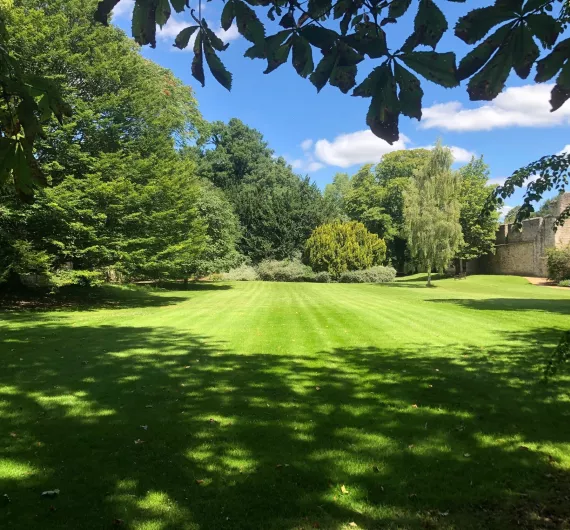The Courtrai Chest
The Courtrai Chest was discovered around 1905 in the village of Stanton St John, a village largely owned by New College. Discovered by Warden Spooner on a Warden’s Progress, it was found in a barn of a College tenant where it was used as a feed bin. The chest is in 17th-century form, but the carved front is probably Flemish, and dates from the 14th century.
The carving illustrates scenes from the Battle of the Golden Spurs fought in Courtrai, Flanders, on 11 July 1302. The battle was, in fact, a citizens’ uprising against the French king who had annexed Flanders some years before. The battle secured an unexpected victory for the Flemish artisan footmen against the army of French knights.
From 2022-2024 the chest was loaned to the 1302 Kortrijk Museum where it featured in an exhibition to mark the 720th anniversary of the Battle of the Golden Spurs. Details of the exhibition can be found here —1302 – Revolt, Battle, Turning point), and you can read more about the Courtrai Chest in ‘Reflections on Medieval Art, Politics, and the Courtrai Chest’ from New College Notes, the College’s scholarly e-journal.
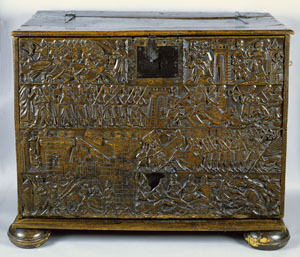
The Hylle Jewel
The Hylle Jewel in the form of a crowned Lombardic initial M was gifted to College in 1455 by the Hylle family of Winchester. This silver gilt ornament - showing the annunciation - set with a diamond, rubies, emeralds and pearls, is thought to date back to 1350 and its craftsmanship is remarkable.
The Jewel featured in an exhibition documenting the life of Wenceslaus IV and his court, through the gothic style art of the time. The exhibition, held in Prague, also commemorated the 600th anniversary of his death (1361-1419).
In addition to displaying the College’s Hylle Jewel, the exhibition included an eclectic mix of ostensoria, reliquaries, tiles, burial gowns, manuscripts, the Humboldt University’s mace, a drinking horn from Dresden and a unique saddle from the Metropolitan Museum of Art in New York.
The exhibition - Wenceslaus IV, King of Bohemia and of the Romans: The Beautiful Style around 1400 – ran from August – November 2019.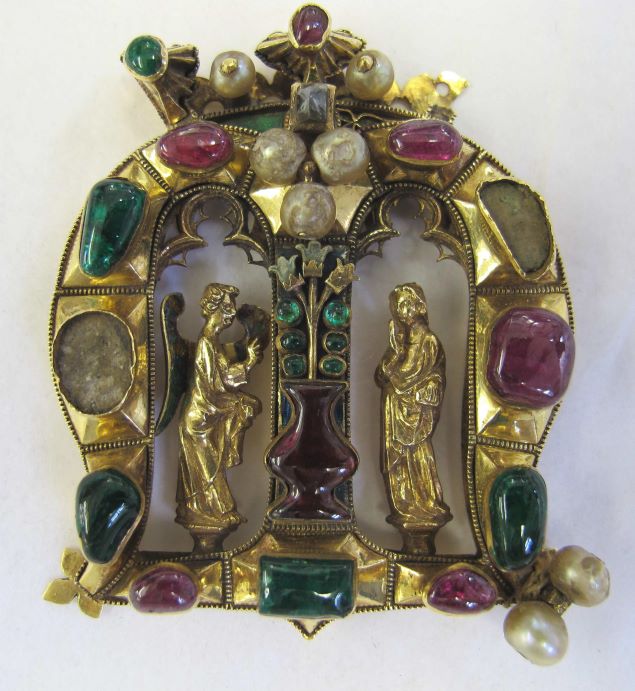
Robert Colquhoun, 'The Spectators', 1947
Robert Colquhoun’s The Spectators has been a part of the College’s Junior Common Room collection since 1960 and recent information suggests that it was painted c 1947. The two spectators are thought to be self-portraits of Robert Colquhoun and Robert MacBryde. In 2014 the portrait was included in a major retrospective dedicated to the work of both artists at the Scottish National Gallery of Modern Art.
The portrait currently features in an exhibition at the Pallant House Gallery which explores the way in which artists in Britain in the 20th and 21st century have portrayed each other to reflect on kinship, identity and their place within artistic circles in the history of art.
The exhibition - Seeing Each Other: Portraits of Artists - will run from 17 May - 2 November 2025.
It will then move on to the Charleston in Lewes for inclusion in their exhibition exploring the lives and work of the 'Two Roberts'.
The exhibition - Robert MacBryde and Robert Colquhoun: Artists, Lovers, Outsiders - will run from 15 October 2025 - 8 March 2026.
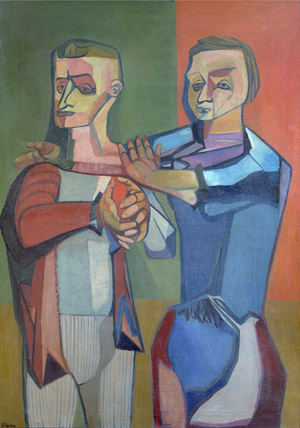
NewBUILD - Richard Woods
Richard Woods’ ambitious NewBUILD installation at New College was created in 2005 and remained in place for several months. This was his first major outdoor work in this country and the project was one of several installations to use ‘red brick’ cladding made of wood to encase buildings, designed to change our perceptions of structure. The building used in New College was the 14th century Long Room and bath-house. The artist employed his trademark block printing system to create a super-sized red brick graphic over the Cotswold stone exterior. The ‘Lego’ effect that this produced stood out in stark contrast to the more traditional medieval architecture that surrounded it, and succeeded in creating debate and dividing opinion. It is true to say that no one remained neutral to the project.

William Gear, 'White Square', 1956
White Square featured in the touring exhibition of William Gear's work, held at the Towner Art Gallery in Eastbourne and the City Art Centre in Edinburgh, to mark the centenary of his birth. The exhibition showcased around 100 pieces of his works of art, and highlighted his development of style from the 1930s through to the 1960s and beyond. White Square, an abstract piece, is part of the College's JCR collection.
The exhibition - William Gear 1915-1997: The Painter that Britain forgot - ran from October 2015 - February 2016.
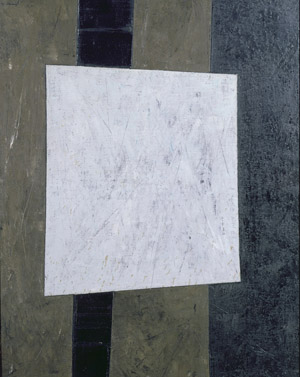
Percy Wyndham Lewis, 'Creation Myth', 1933-36 & 'Newfoundland', 1936-37
Both Newfoundland and Creation Myth were loaned to the Imperial War Museum North for an exhibition of Wyndham Lewis's work - the first retrospective to be held in the UK for almost 40 years. The exhibition was held to coincide with the 60th anniversary of his death, and 100 years after his commission as an official war artist in 1917, and it was part of the IWM North's First World War Centenary programme.
Both paintings were gifted to College in 1953 by Professor and Mrs Russ in memory of their son Charles Rupert Russ, an undergraduate member of the College from 1938-40, who died in active service in 1944, aged just 24. They are part of the College's JCR collection
The exhibition - Wyndham Lewis: Life, Art, War - ran from June 2017 - January 2018.
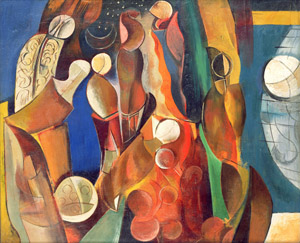
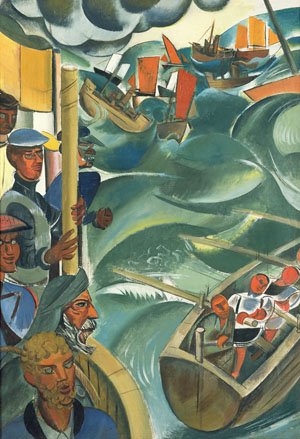
Julian Trevelyan, 'Neolithic Temple', 1959 & 'Taj Mahal', 1968
These two prints were recently exhibited as part of the retrospective on Mary Fedden which was held in the Pembroke College JCR Art Gallery. Julian Trevelyan's inclusion, alongside works by John Piper, Mary Newcombe and John Minton formed a visual explanation of how these artists influenced and inspired Mary's own work. Both aquatint prints are part of the College's JCR (lending) collection.
The exhibition - Mary Fedden: a voice of her own - ran from January - March 2018.
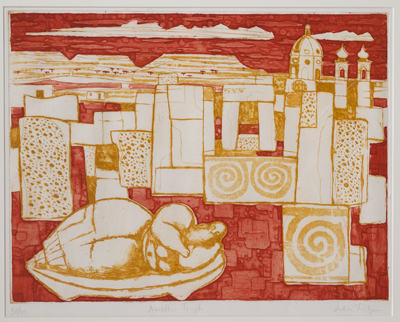
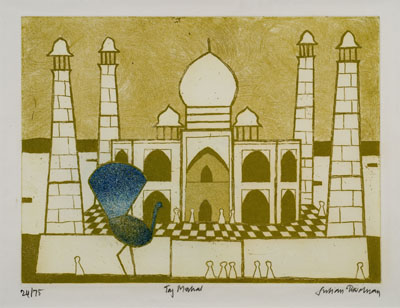
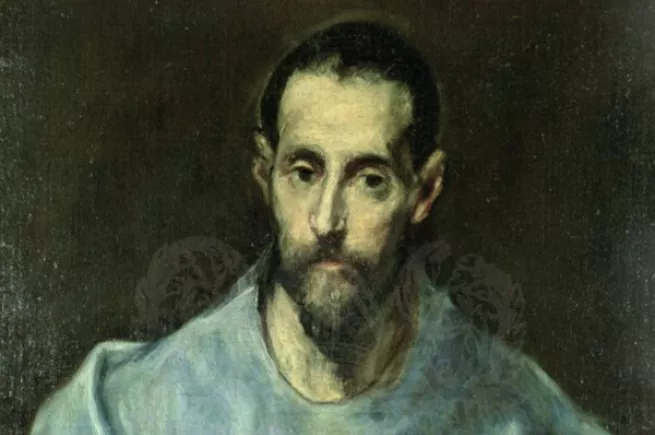
Discover more about New College

